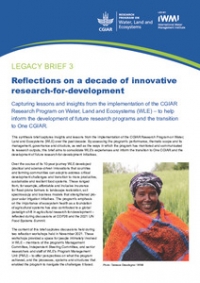This post is part of an online discussion on large-scale land interventions that runs through December 14, 2014. Can these initiatives fulfil their promises? Read more here and comment below or send an 800 word response to a.waldorf@cgiar.org.
A snapshot of integrated landscape management in Asia
What works in integrated landscape management and what doesn’t? As part of a Global Review with the Landscapes for People, Food and Nature Initiative, we surveyed 166 landscape initiatives in South and Southeast Asia to get a better idea of what is going on in the region.
Integrated landscape management is increasingly gaining attention as a way to understand and address the complex and interconnected goals of agricultural production, ecological conservation, and livelihood improvement.
 Rice terracing, lake and wild forests in Kaski District, Nepal. Credit: Bioversity International/J.Zucker
Rice terracing, lake and wild forests in Kaski District, Nepal. Credit: Bioversity International/J.ZuckerWorking at the landscape level means engaging with different actors at different levels, often with competing motivations. Bringing multiple actors together to initiate dialogue, facilitate participatory decision-making, and enable conflict resolution can be extremely rewarding, but is also challenging and time and resource intensive.
A history of integrated resource management
Livelihoods in Asia are highly dependent on natural resources. Countries in the region have long engaged in integrated resource management practices such as community-based natural resource management and civil-society led interventions. In South Asia, examples include community-protected areas like sacred groves in India and community forestry in Nepal. In South East Asia, Marine Protected Areas draw on landscape-based approaches to manage marine and coastal resources and protect local livelihoods.
The global shift towards participatory natural resource management has propelled such community-based approaches further, while policies are responding to global challenges with landscape-scale projects such as REDD+, particularly in the Indo-Malay Peninsula, where interventions move beyond mitigating carbon emissions to sustainable forest management and livelihood development.
Who are the stakeholders and what do they participate in?
The private sector is the least involved stakeholder in landscape initiatives across South and Southeast Asia.
To understand the participation and roles of different stakeholders within integrated landscape initiatives, our survey listed 20 stakeholder types covering local, private sector, government, civil society, donors and research actors.
Overall, government stakeholders, especially local government leaders, participated the most followed by civil society actors (mainly local NGOs) and local farmer associations. The private sector is the least involved stakeholder in landscape initiatives across South and Southeast Asia.
Something interesting that we found was that while donors participated mostly during the design phase, local actors participated more during the implementation phase. This suggests that local stakeholders have a limited influence on investment and planning decisions. At the same time, international actors such as funding agencies, donors, and research and development organizations, were less involved in implementation.
Implications for governance and management of landscape initiatives
Since local actors mainly participated during project implementation, their power to influence investment decisions is negligible.
Including local stakeholders
Overall, the high level of participation of local actors in landscape initiatives is promising. Initiatives with multi-stakeholder processes reported the empowerment of local groups and increased capacity to resolve conflicts as key positive outcomes. However, since local actors mainly participated during project implementation, their power to influence investment decisions is negligible or highly restricted. This begs the question: how can landscape management initiatives move beyond traditional rural development approaches and make multi-stakeholder processes more inclusive?
Engaging private sector stakeholders
The relatively low participation of private sector stakeholders is a cause for concern since they influence funding, investments, political engagement, and market dynamics. Opportunities for private sector engagement in multi-stakeholder processes to create a healthy environment for dialogue and change could exist though, through initiatives such as the Round Table on Sustainable Palm Oil.
What are the conditions for success in large-scale land initiatives?
Stakeholders from all sectors must be able to participate in a meaningful way.
Multi-stakeholder participation has to be underpinned by motivations towards empowerment, equity, trust and learning. Responses from the 166 initiatives showed that when time and effort is spent in building trust, institutionalizing participation and creating a space for sustained dialogue, stakeholder engagement can be successful.
For example, an initiative on building resilience through community-based action in Uttarakhand, India spent a year in stakeholder engagement and institution building activities. This helped forge strong relations between communities, implementing agencies and government bodies.
On the other hand, multi-stakeholder processes were reported as ineffective when communication between stakeholders was weak or non-existent, when conflicting motivations were extreme, or when existing power dynamics discouraged an inclusive dialogue between stakeholders. In particular, getting government actors on board was challenging for many initiatives.
What we are seeing is that integrated landscape management is taking off in Asia, and initiatives are investing in institution building and multi-stakeholder processes. Encouragingly, this has led to increased coordination and cooperation between stakeholders as well as increased ability of local actors to engage with other actors at different scales. In coming years, there is a need to explore innovative and inclusive ways to make current multi-stakeholder processes more robust.



















Comments
Thanks for this insightful review from Asia Chandni! As you might know we have found similar results of low private sector engagement in both Latin America and Africa. Over the past few years we have a working group of conservation and development practitioners who have been meeting monthly to discuss how businesses can be better engaged in landscape initiatives led principally by civil society and government. We welcome institutions in Asia to join us in this effort as we take on collaborative activities to strengthen the business case for participation and reach out to business leaders.
https://peoplefoodandnature.org/challenge/engaging-business-for-integrate...
Glad you liked the review. Although the first phase of our review is complete, perhaps in the next stage we can encourage participation from Asian institutions in the working group. Will definitely keep this in mind!
Add new comment